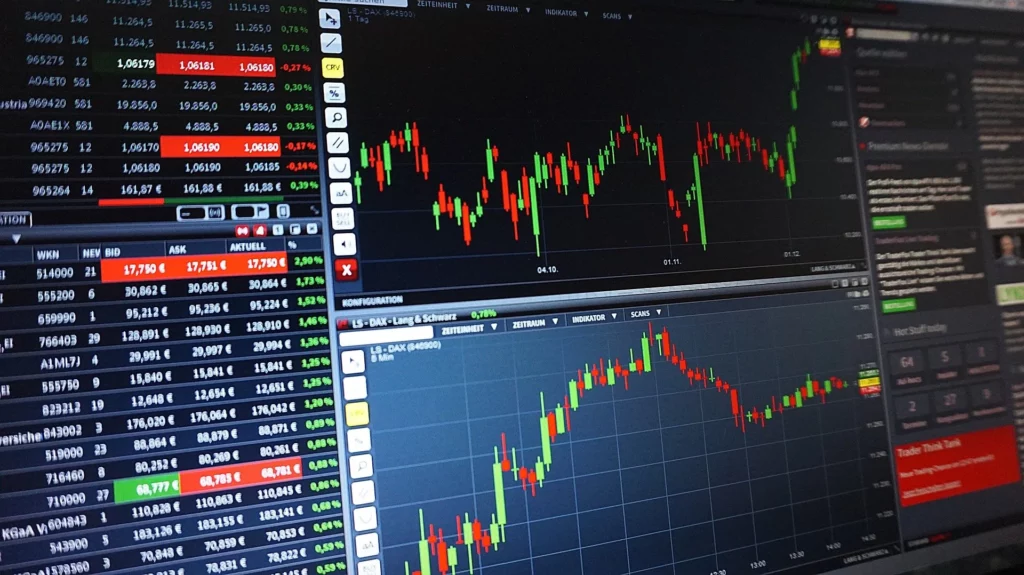
Algorithmic trading, often known as algo trading or automated trading, is a strategy for carrying out financial transactions on the stock market by use of algorithms run on computers. This method involves pre-programming trading techniques into computer systems, and the algorithms analyse market data automatically, make trades, and manage positions without needing any direct human involvement.
Important features of algorithmic trading:
- Automated Decision-Making: Using predetermined rules and instructions, algorithmic trading enables computers to decide whether to purchase or sell depending on particular factors such price changes, technical indicators, or fundamental data.
- Speed: The capacity of algorithmic trading to execute trades at incredibly fast rates is one of its key features. Algorithms’ ability to quickly analyse market data, spot trading chances, and complete deals allows traders to profit from momentary market possibilities.
- Aiming to continuously offer to purchase and sell assets, some algorithmic tactics, like market-making, strive to give liquidity to the market. These algorithms aid in reducing bid-ask spreads and enhancing market performance in general.
- Opportunities for Arbitrage: Algorithmic trading systems may swiftly spot and take advantage of price differences between various markets or financial instruments, creating opportunities for arbitrage.
- Risk management: To restrict transaction size, set stop-loss levels, and prevent excessive market exposure, algorithmic trading might include risk management parameters.
- Backtesting and Optimisation: Traders can evaluate a strategy’s performance using historical data before implementing an algorithm by backtesting it. This procedure aids in the algorithm’s improvement and market-specific optimisation.
- Algorithmic trading is frequently linked to quantitative methods, which use statistical analysis and mathematical models to find trade signals and trends.
Due to technological developments, the availability of high-speed data, and greater access to market exchanges, algorithmic trading has become more and more common in financial markets, including the stock market. Institutional investors, hedge funds, proprietary trading companies, and even some individual traders frequently use it.
The advantages of algorithmic trading are its quickness, effectiveness, lack of human mistake, and capacity to carry out sophisticated methods. However, it also has some dangers, including the possibility of market abnormalities, inaccurate data, and technological breakdowns.
What are the benefits of Algorithmic Trading?
For market players including traders, investors, and financial institutions, algorithmic trading has many advantages. The following are some of the main benefits of algorithmic trading:
- Efficiency and Speed: Algorithmic trading works at high speeds, allowing quick analysis of market data and quick trade execution. This speed enables traders to seize market opportunities, seize minute price differences, and react fast to shifting market circumstances.
- Human mistake is less likely to occur with automated trading systems than it is with manual trading. Algorithms adhere to predetermined guidelines and carry out trades in accordance with objective standards, which minimises the influence of emotional and cognitive biases.Algorithmic trading is frequently linked to quantitative methods, which use statistical analysis and mathematical models to find trade signals and trends.
- Backtesting and Optimisation: Using past market data, algorithmic trading techniques can be tested. Through this approach, traders can evaluate how well their algorithms perform under various market conditions and improve them for better outcomes.
- Increased Trading Volumes and Liquidity: By continuously supplying bid and ask quotes, algorithmic trading helps to increase market liquidity. All market players gain from the improved liquidity since it lowers transaction costs and narrows bid-ask spreads.
- Algorithmic trading provides for the diversification of trading techniques across various assets, markets, or periods. To prevent losses and safeguard wealth, traders might put risk management guidelines into practise.
- Market Monitoring and Reaction: Algorithms are able to continuously scan the market for particular circumstances, and when they do, they can promptly place transactions. This function is especially helpful for trading in volatile markets or outside of typical trading hours.
- Access to Complex Strategies: The use of algorithms in trading makes it possible to implement complex trading strategies that would be difficult or time-consuming to carry out manually. These tactics could include pair trading, statistical arbitrage, and other quantitative methods.
- Trading without emotion is when algorithms place deals based on pre-set criteria, doing away with the need for human emotion. This can help preserve trading discipline and stop impulsive acts amid erratic market conditions.
Overall, algorithmic trading has a lot to offer in terms of speed, effectiveness, fewer errors, and accessibility to sophisticated techniques. Due of these advantages, institutional investors, hedge funds, and traders who want to take advantage of market opportunities in a highly competitive financial environment frequently choose algorithmic trading. To be competitive and adaptable under volatile market conditions, market participants must create and apply reliable algorithms, follow risk management procedures, and constantly review and revise their plans.
Advantages and DisAdvantages of Algorithmic Trading
Advantages of Algorithmic Trading:
- Efficiency and Speed: Because algorithms can execute trades quickly, traders can take advantage of market opportunities and respond quickly to shifting conditions.
- Reduced Human Error: Automated trading systems do away with any chance of human errors brought on by feelings, cognitive biases, or incorrect manual entry.
- Algorithm backtesting and optimisation: Trading methods can be optimised for various market conditions by using previous data to evaluate the performance of algorithms.
- Increased Trading Volumes and Liquidity: By continuously giving bid and ask quotes, cutting bid-ask spreads, and lowering transaction costs, algorithmic trading helps to increase market liquidity.
- Diversification and risk management: Automated trading enables traders to diversify across a range of assets and markets, and they can add risk management controls to limit losses.
- Market Monitoring and Reaction: Algorithms are capable of continuously monitoring the market and promptly executing deals when certain criteria are satisfied, even outside of typical trading hours.
- Access to Complex tactics: Algorithmic trading makes it possible to implement complex tactics that would otherwise be challenging or time-consuming to carry out manually.
- Trading without emotion is possible because to algorithms that adhere to predetermined rules, which stop emotional decision-making and uphold trading discipline.
- Cost Savings: Automated trading eliminates the need for human intervention, which saves money for both traders and financial institutions.
- Market Integration: By seamlessly integrating with electronic trading platforms and international stock exchanges, algorithmic trading offers access to a variety of markets and assets around the world.
Disadvantages of Algorithmic Trading:
- Technical Failure Risk: Algorithmic trading systems are susceptible to malfunctions, software faults, and connectivity problems that may have unanticipated results and cause losses.
- Over-Optimization and Curve Fitting: Over-optimization, which occurs when algorithms perform well on historical data but poorly in real trading owing to shifting market conditions, can be caused by excessive backtesting and optimisation.
- Risk of Market Manipulation: In order to protect market integrity, regulators actively watch algorithmic trading for signs of market manipulation or flash crashes.
- Complexity and Expertise: Robust algorithm development and implementation require technical know-how and an understanding of financial markets, which makes it difficult for novice traders.
- Dependence on Historical Data: Because algorithms mainly rely on historical data, unforeseen market events or structural changes may call into question how well they have performed in the past.
- Regulators may closely examine algorithmic trading for possible market misuse, unfair benefits, or a lack of transparency.
- Lack of Adaptability: Algorithms may be slow to respond to unexpected market changes or new information, resulting in subpar performance in circumstances that change quickly.
- High-frequency trading (HFT) tactics may entail trading with extremely low latency, raising questions about the stability and fairness of markets.
- Proprietary algorithms may be viewed as “black boxes” with little transparency, which raises questions about the secrecy of trading decisions.
- Competition and Technology Costs: Because of the intense competition in the algorithmic trading market, traders must make significant investments in infrastructure and cutting-edge technology to stay competitive.
Conclusion
In the world of financial markets, algorithmic trading is a two-edged sword. Because of its benefits, including accessibility to sophisticated tactics, reduced human error, speed, and efficiency, it is a popular instrument among traders and financial institutions. Algorithm backtesting and optimisation has the potential to improve trading efficiency and risk control.
Algorithmic trading, however, also has some significant risks and drawbacks. The difficulties that traders and developers must overcome include technical issues, over-optimization, market manipulation, and regulatory issues. In addition, novice traders may find it difficult to design and use algorithms due to their intricacy and technical requirements.
Market participants need to establish strict risk management procedures and be aware of potential hazards in order to fully capitalise on the advantages of algorithmic trading. Successful algorithmic trading requires constant algorithm monitoring, strategy diversification, and flexibility in response to shifting market conditions.
Furthermore, even if algorithmic trading has revolutionised the financial markets, maintaining a balance between its application and human engagement is still essential. Algorithmic tactics can be effectively complemented by the mix of human discretion, intelligence, and market nuances.
FOR MORE INFO CLICK THIS SITE:https://learningsharks.in/
FOLLOW OUR PAGE:https://www.instagram.com/learningsharks/?hl=en








